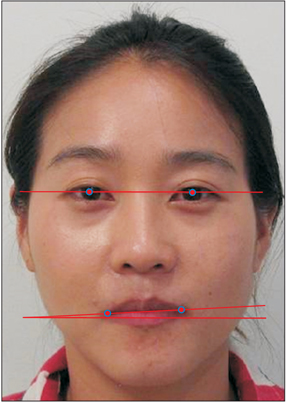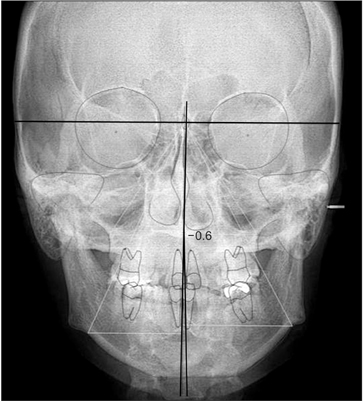Korean J Orthod.
2016 Mar;46(2):81-86. 10.4041/kjod.2016.46.2.81.
The influence of age on lip-line cant in adults: a cross-sectional study
- Affiliations
-
- 1Department of Orthodontics, Institute of Craniofacial Deformity, College of Dentisrty, Yonsei University, Seoul, Korea. hwang@yuhs.ac
- 2Private Practice, Seongnam, Korea.
- KMID: 2159355
- DOI: http://doi.org/10.4041/kjod.2016.46.2.81
Abstract
OBJECTIVE
The aims of this study were to assess the direction and degree of lip-line cant in Korean adult orthodontic patients and to identify the effects of sex and age on changes in the cant severity.
METHODS
In this cross-sectional retrospective study, lip-line cant was measured in the frontal photographs of 585 Korean patients (92 men and 493 women) aged 18-48 years. The outcome variables (direction and degree of lip-line cant) were assessed in terms of predictor variables (sex, age, sagittal skeletal relationship, and menton deviation angle).
RESULTS
The direction of lip-line cant did not differ according to sex, age, or skeletal classification. Patients had 1.6° of lip-line cant on average before orthodontic treatment. Middle-aged adults displayed a significant trend toward a lower degree of lip-line cant compared to younger adults (p < 0.01). Multiple linear regression analysis showed that the degree of lip-line cant was weakly negatively correlated with age (p < 0.001).
CONCLUSIONS
While the direction of lip-line cant did not differ according to the parameters explored here, the degree of cant was correlated with age in adults, independent of menton deviation. Specifically, middle-aged adults tended to display significantly lower degrees of lip-line cant than did younger adults.
Keyword
Figure
Cited by 1 articles
-
Study on the perception of orthodontic treatment according to age: A questionnaire survey
Yoonji Kim
Korean J Orthod. 2017;47(4):215-221. doi: 10.4041/kjod.2017.47.4.215.
Reference
-
1. Ferrario VF, Sforza C, Poggio CE, Tartaglia G. Distance from symmetry: a three-dimensional evaluation of facial asymmetry. J Oral Maxillofac Surg. 1994; 52:1126–1132.
Article2. Shah SM, Joshi MR. An assessment of asymmetry in the normal craniofacial complex. Angle Orthod. 1978; 48:141–148.3. Bishara SE, Burkey PS, Kharouf JG. Dental and facial asymmetries: a review. Angle Orthod. 1994; 64:89–98.4. Peck S, Peck L, Kataja M. Skeletal asymmetry in esthetically pleasing faces. Angle Orthod. 1991; 61:43–48.5. Hwang HS, Youn IS, Lee KH, Lim HJ. Classification of facial asymmetry by cluster analysis. Am J Orthod Dentofacial Orthop. 2007; 132:279.e1–279.e6.
Article6. Cho JH, Kim EJ, Kim BC, Cho KH, Lee KH, Hwang HS. Correlations of frontal lip-line canting with craniofacial morphology and muscular activity. Am J Orthod Dentofacial Orthop. 2007; 132:278.e7–278.e14.
Article7. Kim YH, Jeon J, Rhee JT, Hong J. Change of lip cant after bimaxillary orthognathic surgery. J Oral Maxillofac Surg. 2010; 68:1106–1111.
Article8. Padwa BL, Kaiser MO, Kaban LB. Occlusal cant in the frontal plane as a reflection of facial asymmetry. J Oral Maxillofac Surg. 1997; 55:811–816. discussion 817
Article9. Hwang HS, Min YS, Lee SC, Sun MK, Lim HS. Change of lip-line cant after 1-jaw orthognathic surgery in patients with mandibular asymmetry. Am J Orthod Dentofacial Orthop. 2009; 136:564–569.
Article10. Gibelli D, Codari M, Rosati R, Dolci C, Tartaglia GM, Cattaneo C, et al. A quantitative analysis of lip aesthetics: the influence of gender and aging. Aesthetic Plast Surg. 2015; 39:771–776.
Article11. Rosati R, Codari M, Maffessanti F, Dolci C, Ferrario VF, Sforza C. The labial aging process: a surface analysis-based three-dimensional evaluation. Aesthetic Plast Surg. 2014; 38:236–241.
Article12. Kim HH, Lee JW, Cha KS, Chung DH, Lee SM. Three-dimensional assessment of upper lip positional changes according to simulated maxillary anterior tooth movements by white light scanning. Korean J Orthod. 2014; 44:281–293.
Article13. Denize ES, McDonald F, Sherriff M, Naini FB. Facial profile parameters and their relative influence on bilabial prominence and the perceptions of facial profile attractiveness: A novel approach. Korean J Orthod. 2014; 44:184–194.
Article14. An SM, Choi SY, Chung YW, Jang TH, Kang KH. Comparing esthetic smile perceptions among laypersons with and without orthodontic treatment experience and dentists. Korean J Orthod. 2014; 44:294–303.
Article15. Hurmerinta K, Rahkamo A, Haavikko K. Comparison between cephalometric classification methods for sagittal jaw relationships. Eur J Oral Sci. 1997; 105:221–227.
Article16. Ferrario VF, Sforza C, Ciusa V, Dellavia C, Tartaglia GM. The effect of sex and age on facial asymmetry in healthy subjects: a cross-sectional study from adolescence to mid-adulthood. J Oral Maxillofac Surg. 2001; 59:382–388.
Article17. Pirttiniemi PM. Associations of mandibular and facial asymmetries--a review. Am J Orthod Dentofacial Orthop. 1994; 106:191–200.
Article18. Melnik AK. A cephalometric study of mandibular asymmetry in a longitudinally followed sample of growing children. Am J Orthod Dentofacial Orthop. 1992; 101:355–366.
Article19. Michiels LY, Tourne LP. Nasion true vertical: a proposed method for testing the clinical validity of cephalometric measurements applied to a new cephalometric reference line. Int J Adult Orthodon Orthognath Surg. 1990; 5:43–52.20. Yogosawa F. Predicting soft tissue profile changes concurrent with orthodontic treatment. Angle Orthod. 1990; 60:199–206.21. Marinetti CJ. The lower muscular balance of the face used to lift labial commissures. Plast Reconstr Surg. 1999; 104:1153–1162. discussion 1163-4
Article22. Pélissier P, Pistre V, Bustamante K, Martin D, Baudet J. The modiolus. Comparative anatomy, embryological and physiological review, surgical importance. Ann Chir Plast Esthet. 2000; 45:41–47.23. Coleman SR, Grover R. The anatomy of the aging face: volume loss and changes in 3-dimensional topography. Aesthet Surg J. 2006; 26:S4–S9.
Article24. Park DM. Total facelift: forehead lift, midface lift, and neck lift. Arch Plast Surg. 2015; 42:111–125.
Article25. Coleman SR. Long-term survival of fat transplants: controlled demonstrations. Aesthetic Plast Surg. 1995; 19:421–425.
Article26. Carruthers J, Carruthers A. Aesthetic botulinum A toxin in the mid and lower face and neck. Dermatol Surg. 2003; 29:468–476.
Article27. Lee MS, Chung DH, Lee JW, Cha KS. Assessing soft-tissue characteristics of facial asymmetry with photographs. Am J Orthod Dentofacial Orthop. 2010; 138:23–31.
Article28. Georgiou CA, Benatar M, Bardot J, Santini J, Sicard BC. Morphologic variations of the philtrum and their effect in the upper lip lift. Plast Reconstr Surg. 2014; 134:996e–997e.
Article29. Ferrús-Torres E, Valmaseda-Castellón E, Berini-Aytés L, Gay-Escoda C. Informed consent in oral surgery: the value of written information. J Oral Maxillofac Surg. 2011; 69:54–58.
Article30. Piérard GE, Hermanns-Lê T, Gaspard U, Piérard-Franchimont C. Asymmetric facial skin viscoelasticity during climacteric aging. Clin Cosmet Investig Dermatol. 2014; 7:111–118.
Article
- Full Text Links
- Actions
-
Cited
- CITED
-
- Close
- Share
- Similar articles
-
- An analysis of soft tissue profile
- Influence of Advance Directives' Self-efficacy of Community-dwelling Older Adults on the Completion of Advance Directives: Mediating the Effect of Intention for Advance Directives: A Cross-Sectional Study
- Abbe Flap to Correct Tight Upper Lip Resulting from Secondary Deformities of Unilateral and Bilateral Cleft Lip
- A cross-sectional study on oral health literacy and its influencing factors among adults: II. Functional oral health literacy
- Evaluation of the lip during smile in normal occlusion adults



